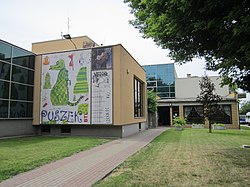Białystok Puppet Theatre
This article has multiple issues. Please help improve it or discuss these issues on the talk page. (Learn how and when to remove these messages)
|
| Białostocki Teatr Lalek | |
 Theatre building in 1 Kalinowskiego Street | |
 | |
| Address | 1 Kalinowskiego Street Białystok Poland |
|---|---|
| Coordinates | 53°07′50.88″N 23°09′36″E / 53.1308000°N 23.16000°E |
| Years active | 1953 - present |
| Website | |
| https://www.btl.bialystok.pl | |
Bialystok Puppet Theater (Template:Lang-pl) is one of the oldest Polish puppet theaters. It is located at 1 Kalinowskiego Street in Białystok. Its repertoire includes performances for children as well as puppetry adaptations of international literature for adults.[1]
Białostocki Teatr Lalek was started up in 1953, when a group of puppeteers led by Piotr Sawicki was granted a state subsidy. The theatre has been active ever since, producing 3 to 5 new performances each season. The Białystok-based stage employs a variety of puppet techniques and forms. Rod, glove and string puppets are used, and different forms of visual, object, mask and drama theatre are also performed.
History
Białystok Puppet Theatre was officially established in 1953, when the Ministry of Culture and National Heritage granted it a subsidy and the status of a professional stage.
This article may be confusing or unclear to readers. (June 2020) |
Its history, however, dates back to pre-WWII when Helena Pacewicz and Piotr Sawicki (the theater's first managers) founded an amateur puppet theater in Bialystok in 1937.[2]
The nationalization of the theater took place in 1960, and in 1972 the adult stage was created (the first in Poland). The Puppet Theater Actor Study was founded in 1974 (later transformed into the Puppetry Department of the Aleksander Zelwerowicz National Academy of Dramatic Art in Warsaw in Warsaw).[2]
Between 1975 and 1979, the first building in Poland intended for the puppet theater was erected. It houses three stages: Large (200 seats), Small (100 seats) and Rehearsal Room (40 seats). One of the leading puppet theatres in Poland, a venue where the greatest puppet artists have worked, including Jan Wilkowski, Krzysztof Rau, Piotr Tomaszuk. In existence since 1953, its tradition dates back to before World War II. An amateur puppet theatre was formed in Bialystok in 1937. Its founders were Helena Pacewicz and Piotr Sawicki, the latter later becoming the Bialystok Puppet Theatre's first manager (1953-1960). The theatre has been based at 1 Kalinowskiego St. in Bialystok since 1979. This is Poland's first theatre building built specially to house a puppet theatre.
Outstanding Feats
The theatre has been directed by renown Polish puppeteer artists: Piotr Sawicki, Joanna Piekarska, Krzysztof Rau, Wojciech Kobrzyński and Wojciech Szelachowski. Since September 2005 BTL’s director is Marek Waszkiel, a puppet theatre historian and theatre critic.
During its history BTL cooperated with many outstanding artists. The productions carried out by them in Białystok left a distinct mark on the entire Polish art of puppetry. Jan Wilkowski and Adam Kilian produced their famous Dekameron 8.5 / Decameron 8.5 and Zielona gęś / The Green Goose at the BTL. Piotr Tomaszuk, a renown artist of the stage was connected with the BTL since his début in the 1980s. He produced several unforgettable shows: Polowanie na lisa / Fox hunting by Sławomir Mrożek and Turlajgroszek / Roll the Pea, and most recently Lis / The Fox by a young Polish puppet playwright Marta Guśniowska. Tadeusz Słobodzianek, a renown contemporary Polish playwright is also among acclaimed Polish artists who used to be affiliated with BTL.
Białostocki Teatr Lalek is one of the oldest Polish puppet stages to propose a repertoire for adults. Since the 1970s, works by world’s best literary authors regularly appear on its playbill: Boccaccio, Calderon, Rostand, Gogol, Bernhard, Różewicz, Szukszyn, Mrożek and Gałczyński. BTL was the first puppet theatre in Poland to have specially designed premises. In 1979, the city founded a building which houses three stages with total of 340 seats. Over the past 30 years, the theatre organized numerous national and international puppetry festivals, such as a festival of solo puppeteers and national meetings of puppet theatres.
In 1974 Białostocki Teatr Lalek started up an actor’s studio, and within a year it was transformed into the Puppetry Art Department of the Warsaw Theatre Academy. At present, nearly all the actors of the company are graduates of this
==Today's theatre==
Today's BTL specialises in shows for children, shows for adults and experimental forms of puppet perfomance. Children’s showings are usually stage adaptations of well-known fables and popular literature for children. Continuous work in the adult performances is a unique phenomenon. Most of these productions are created with the cooperation of international artists. Recently they were Marian Pecko (Slovakia), Duda Paiva (Holland), Alain Lecucq (France), Andras Veres (Hungary), Julija Skuratova (Lithuania), Frank Soehnle (Germany) and Christoph Bochdansky (Austria); Białostocki Teatr Lalek is open to international cooperation, theatre traineeships for young artists, studio projects and workshop meetings. Every year BTL takes part in numerous festivals in Poland and abroad.
BTL runs workshops for children, theatre lessons for primary school students, as well as public readings of puppet plays for children, thus engaging in educational activity on a large scale. Every year the theatre also publishes collections of plays and organises exhibitions at the BTL Gallery. The premises of the theatre house an unusual Puppets' Cellar. The collection of puppets, masks, costumes and elements of stage design have been gathered over the years of BTL’s work and invite the visitor to get lost in the magic of puppet theatre.
References
- ^ "Białystok Puppet Theatre". World Encyclopedia of Puppetry Arts. 2016-05-06. Retrieved 2020-06-09.
- ^ a b Historia teatru
External links
![]() Media related to Białystok Puppet Theatre at Wikimedia Commons
Template:Https://culture.pl/en/artist/btl-bialystok-puppet-theatre
Media related to Białystok Puppet Theatre at Wikimedia Commons
Template:Https://culture.pl/en/artist/btl-bialystok-puppet-theatre
}}